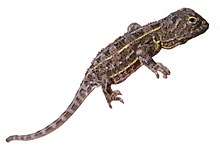Tympanocryptis pinguicolla
| Tympanocryptis pinguicolla | |
|---|---|
 | |
| Tympanocryptis pinguicolla | |
| Scientific classification | |
| Kingdom: | Animalia |
| Phylum: | Chordata |
| Class: | Reptilia |
| Order: | Squamata |
| Suborder: | Iguania |
| Family: | Agamidae |
| Genus: | Tympanocryptis |
| Species: | T. pinguicolla |
| Binomial name | |
| Tympanocryptis pinguicolla Mitchell, 1948 | |
Tympanocryptis pinguicolla, also known as grassland earless dragon, is one of 15 documented species of a relatively small dragon belonging to the genus Tympanocryptis. It is recognised as an endangered species. It is found at higher altitudes and in regions that have cooler temperatures than any other earless dragon. The grassland earless dragon is the only representative of the family Agamidae that is restricted to natural temperate grasslands.
Description
Females are oviparous.
Habitat and distribution
Remnant populations live in Canberra and Cooma, New South Wales. It was historically found in Victoria, but is now presumed to be extinct there.[1]
They prefer sites with both taller tussock and shorter grasses.
Less than 1% of native temperate grasslands remain.[2] Loss of habitat after European settlement has seen numbers drop dramatically. Sustained high-intensity grazing that leaves little or no ground cover is likely detrimental, particularly in areas with few surface rocks.[3] The grassland earless dragon is generally not present where native grassland has been substantially modified through cultivation (ploughing or cropping).
Cultivation results in changes to plant species composition, structure and possibly food availability (arthropods) that is likely to result in severe degradation or complete removal of suitable habitat for the species.
"Observations indicate that arthropod burrows, surface rocks, or other similar refuge sites may be necessary for the continued persistence of populations of dragons, by providing thermal refugia (Nelson 2004)."[3]
They are known to make use of arthropod burrows (in ACT) but they have also been known to make shelters underneath rocks (in Vic). Shelter sites may vary with season and local environmental conditions. Soil disturbance, such as ploughing or compaction, might also result in destruction of arthropod burrows (shelter sites) and possibly a reduction in the abundance, at least in the short-term, of burrow forming arthropods.
A radio-tracking study found that "burrows excavated by arthropods are an important resource for grassland earless dragons, with individuals having one or two home burrows around which they maintained home ranges of between 925 m2 and 4768 m2."[2]
"May survive short-term disturbance from fire (Nelson et al. 1998a)."[3]
Reproduction
Tympanocryptis pinguicolla lays 3-6 eggs in late spring or early summer. Their young hatch in late summer (possibly disperse soon after hatching), grow to adult size rapidly (by late autumn-early winter), mate the following spring, and often die within one year of birth. They can reach the age of 5 within captivity.
References
- ↑ Melville, Goebel, Starr, Keogh, Austin. "Conservation genetics and species status of an endangered Australian dragon, Tympanocryptis pinguicolla (Reptilia: Agamidae)" (PDF). Retrieved 11 May 2018.
- 1 2 Stevens, Evans, Osborne, Sarre (2009). "Home ranges of, and habitat use by, the grassland earless dragon (Tympanocryptis pinguicolla) in remnant native grasslands near Canberra". Retrieved 11 May 2018.
- 1 2 3 https://www.environment.gov.au/system/files/resources/43f24013-b621-4ff6-bf09-34da942e8ced/files/tympanocryptis-pinguicolla.pdf
